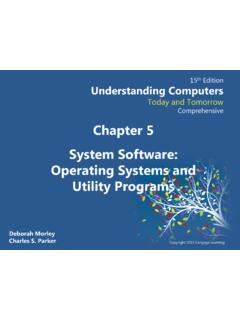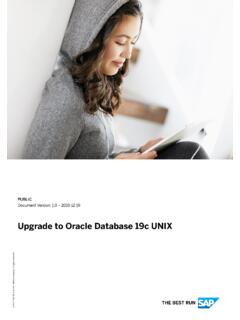Transcription of Transparency in Distributed Systems
1 Transparency in Distributed Systems By Sudheer R Mantena Abstract The present day network architectures are becoming more and more complicated due to heterogeneity of the network components and mainly due to the extensive use of the Internet services. For instance a company may have many branches operating at different geographical locations and may need to interact with all other branches for day-to-day activities. This gives rise to Distributed computing environment where the resources are located at different locations and sharing of the resources such as printers, files, web pages or database records. The design and implementation of such Systems poses greater challenges. The user should not be worried about the intrinsic details of the Distributed system being used, how it is implemented and handles different situations. This points to the characteristic of the Distributed system , being transparent.
2 The different transparencies, which come across Distributed Systems and how they are taken care of, are discussed. 1. Introduction Distributed system architecture consists of a collection of workstations and servers connected by a local area network and distribution middle ware. The clients or the users can access these workstations at the same time and doing the computation at there own end. They can also share the remote resources provided by the servers and the workstations [1]. This kind of Distributed computing environment has many advantages like heterogeneity of the network components, availability of the resources etc. The characteristics of the Distributed Systems are, multiple autonomous components the components by themselves have the computational power and access the shared resources for further operations, the components may not be shared by all the existing components in the system , resources sometimes may not be accessible due to some kind of failures, concurrent processing of tasks is allowed on different processors, multiple points of access control, the middle ware need to provide security by some kind of encryption and CSE 6306 Advanced Operating Systems 2transparency the aspects of distribution are made invisible to the client or the application user to provide a single centralized view of the system without worrying about the design and implementation details of the system [2].
3 Our focus is on understanding the types of transparencies involved in Distributed Systems and implementation with the help of a case study mentioned in later sections. The paper is organized as follows: Section 2 introduces the Distributed system characteristics and defines the Transparency issues Section 3 defines the different types of transparencies involved Section 4 deals with some particular transparencies along with a case study and Section 5 gives the conclusion with references. 2. Distributed system Features As we have seen Distributed system is a collection of autonomous Systems , which are connected together by means of a local area network. Even though Distributed Systems are found in many applications designing them is a difficult task, as many issues have to be considered during its implementation. Any ideal Distributed system should have all the features discussed below.
4 But it may not be possible to incorporate all of them, so depending on the application requirements the features required are considered. The following issues have to be taken care while designing. [2] Heterogeneity Openness Security Scalability Fault Tolerance Concurrency Transparency : The Distributed Systems should be perceived as a single entity by the users or the application programmers rather than as a collection of autonomous Systems , which are cooperating. The users should be unaware of where the services are located and also the transferring from a local machine to a remote one should also be transparent. CSE 6306 Advanced Operating Systems 3 3. Types of Transparencies The implementation of the Distributed system is very complex, as a number of issues have to be considered to achieve its final objective.
5 The complexities should not worry the user of the Distributed system from using it , the complexities should be hidden from the user who uses the Distributed system . This property of the Distributed system is called its Transparency . There are different kinds of transparencies that the Distributed system has to incorporate. The following are the different transparencies encountered in the Distributed Systems [3] [2]. 1. Access Transparency : Clients should be unaware of the distribution of the files. The files could be present on a totally different set of servers which are physically distant apart and a single set of operations should be provided to access these remote as well as the local files. Applications written for the local file should be able to be executed even for the remote files. The examples illustrating this property are the File system in Network File system (NFS), SQL queries, and Navigation of the web.
6 2. Location Transparency : Clients should see a uniform file name space. Files or groups of files may be relocated without changing their pathnames. A location transparent name contains no information about the named object s physical location. This property is important to support the movement of the resources and the availability of services. The location and access transparencies together are sometimes referred as Network Transparency . The examples are File system in NFS and the pages of the web. 3. Concurrency Transparency : Users and Applications should be able to access shared data or objects without interference between each other. This requires very complex mechanisms in a Distributed system , since there exists true concurrency rather than the simulated concurrency of a central system .
7 The shared objects are accessed simultaneously. The concurrency control and its implementation is a hard task. The examples are NFS, Automatic Teller machine (ATM) network. CSE 6306 Advanced Operating Systems 44. Replication Transparency : This kind of Transparency should be mainly incorporated for the Distributed file Systems , which replicate the data at two or more sites for more reliability. The client generally should not be aware that a replicated copy of the data exists. The clients should also expect operations to return only one set of values. The examples are Distributed DBMS and Mirroring of Web pages. 5. Failure Transparency : [4] Enables the concealment of faults, allowing user and application programs to complete their tasks despite the failure of hardware or software components. Fault tolerance is provided by the mechanisms that relate to access Transparency .
8 The Distributed system are more prone to failures as any of the component may fail which may lead to degraded service or the total absence of that service. As the intricacies are hidden the distinction between a failed and a slow running process is difficult. Examples are Database Management Systems . 6. Migration Transparency : This Transparency allows the user to be unaware of the movement of information or processes within a system without affecting the operations of the users and the applications that are running. This mechanism allows for the load balancing of any particular client, which might be overloaded. The Systems that implement this Transparency are NFS and Web pages. 7. Performance Transparency : Allows the system to be reconfigured to improve the performance as the load varies. 8. Scaling Transparency : A system should be able to grow without affecting application algorithms.
9 Graceful growth and evolution is an important requirement for most enterprises. A system should also be capable of scaling down to small environments where required, and be space and/or time efficient as required. The best- Distributed system example implementing this Transparency is the World Wide Web. CSE 6306 Advanced Operating Systems 54. Case Study: Andrew File system An ideal Distributed system , which provides all the above-mentioned transparencies, is not always possible and all these transparencies may not be required by all the Distributed Systems . The need for any particular Transparency mainly depends on the application of the Distributed system . For example the replication Transparency is more pronounced in case of Distributed file Systems . The process migration Transparency is more relevant in case of Distributed Systems which are more computational centric as they have to balance the load by executing the process at different or less loaded sites.
10 The transparencies could be defined and implemented according to the Distributed system under development. If we take the example of Distributed File system (DFS), the sharing of the storage devices and the data is very important. For the purpose of case study let us consider Andrew File system (AFS), which is developed at the Carnegie-Mellon university (CMU). The AFS is a Distributed File system , which was developed to meet the campus wide requirement of connecting all the workstations of the CMU and also to enable the sharing of information between the workstations. The main design task of the AFS is to scale to a large number of workstations [13]. The high speed Local Area Network (LAN) technology was used to connect all the workstations on the campus. As the campus is wide spread, making the entire system physically secure is not possible. Selected numbers of workstations are physically secured.




